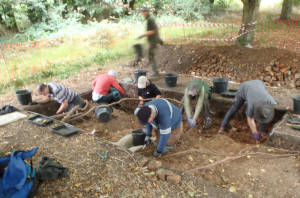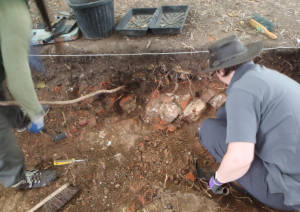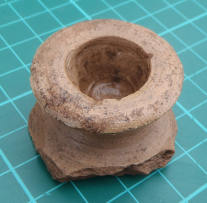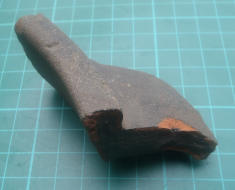01 Sep 2021
Forty Hall Summer Dig - Day 10

A drizzly and at times chilly morning didn't dampen our spirits today as we returned to Forty Hall for the final five-day stretch of our two-week dig on the site of Elsyng Tudor palace.

This morning we decided to have one last roll of the dice in our effort to find the extended course of the previously excavated brick water conduit we relocated a few days ago. We strung a line out along the stretch of brickwork we have exposed at the west end of trench one, and extended the line out east into the middle of Forty Hall's lime tree avenue, where we laid out a 1.5 metre square trench which hopefully should be clear of any historical tree planting pits which we suspect are the reason we didn't find the conduit running through the east end of trench 1. We've only got as far as deturfing and topsoil removal, but if the conduit does run straight in this direction we should only have to dig down 60cm or so to find it.

Meanwhile at the west end of trench two, the sloping rubble-filled context is looking more and more like a rubble-filled demolition cut. We haven't quite finished removing the all of the rubble in this area, but where we have done so it does seem to show a steep cut into a sloping brickearth surface; moreover at the north section of the trench the rubble fragments are very substantial and large chunks are mortared together.
We strongly suspect that the structure this rubble derives from is less than a few of metres away, although from the size of the apparent cut, it may well be that any in-situ wall foundations have been removed entirely. Ideally we'd like to extend this part of the trench north, but at this point we may be limited by time and person-power.

In any case, the context continued to throw up plenty of great finds today, including an unusual ceramic fragment that had us all scratching our heads for a few minutes until the penny dropped.
At first glance it looked like a stubby cylindrical spout, but the hole doesn't go all the way through, which led to suggestions ranging from a decorative foot to a suspension point for rope straps.

Fortunately the site director then remembered an identical example we found a few years ago, which was identified as a ceramic candle-holder, which would have had a surrounding dish to catch dripping wax.
Although we only removed topsoil from the new 1.5m square trench, it did turn up a second fragment of medieval pottery - part of a large handle and rim of what was probably a chunky jar, in a slightly finer fabric than the previous piece but again tentatively dated to the 14th century.